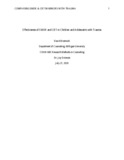| dc.contributor.advisor | Drinnon, Joy | |
| dc.contributor.author | Brannock, David | |
| dc.date.accessioned | 2020-07-27T12:52:42Z | |
| dc.date.available | 2020-07-27T12:52:42Z | |
| dc.date.issued | 2020-07 | |
| dc.identifier.uri | http://hdl.handle.net/11558/5138 | |
| dc.description.abstract | The main purpose of this systematic review was to compare the effectiveness of eye movement desensitization and reprocessing (EMDR) and cognitive behavioral therapy (CBT) in children and adolescents who experienced trauma. Empirical studies suggest both treatment methods are effective in alleviating trauma in adults, so this review examined the efficacy of EMDR and CBT in minors. A secondary question was to compare these two methods in treating depression, which often accompanies posttraumatic stress disorder (PTSD). From electronic databases (Milligan OneSearch and Google Scholar), six studies of randomized controlled trials from 2004-2017 were identified. Four theoretical articles and six meta-analyses were included for background information. The results showed both EMDR and CBT are highly effective in treating trauma in children and adolescents. Neither method reduced PTSD distress significantly better than the other. EMDR was slightly more efficient in lessening traumatic symptoms. CBT was slightly more effective in reducing depression. | en_US |
| dc.language.iso | en_US | en_US |
| dc.subject | Eye Movement Desensitization and Reprocessing (EMDR) | en_US |
| dc.subject | Cognitive Behavioral Therapy (CBT) | en_US |
| dc.subject | Post-Traumatic Stress Disorder (PTSD) | en_US |
| dc.subject | Children | en_US |
| dc.subject | Adolescents | en_US |
| dc.subject | Trauma | en_US |
| dc.subject | Depression | en_US |
| dc.title | Effectiveness of EMDR and CBT in Children and Adolescents with Trauma | en_US |
| dc.type | Working Paper | en_US |

